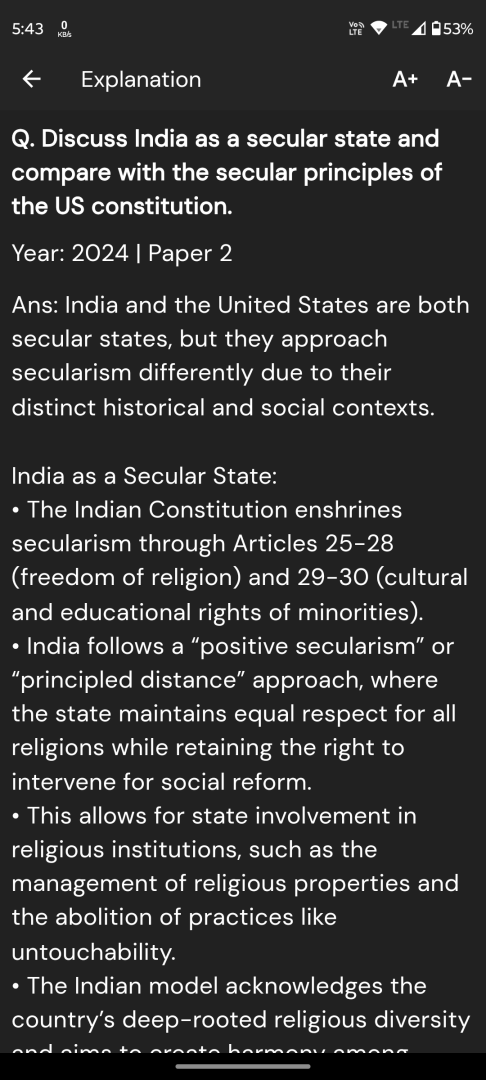Direction (Q. Nos. 60-69) : Read the following passage and answer the questions that follow. Your answers to these questions should be based on the passage only :
Everyone is fascinated by identical twins: they look the same – even advanced digital imaging systems sometimes fail to tell them apart – and yet they have different personalities and abilities.
Literature and detective stories depend upon them for providing a plot twist or a mystery. In reality, too, there have been numerous cases of one twin impersonating the other for a joke, to escape punishment or to advance a romantic interest. They may have the same eyes, the same hair colour, the same smile, but one will be shy and the other more outgoing, or one cleverer or funnier or kinder than the other and this despite their having the same DNA. They do not, however, have the same fingerprints, which are believed to be determined by environmental factors, twins like spending time with each other – often to the exclusion of others. In fifty percent of cases, they even develop their own secret language, furthermore, it is commonly believed that they have the ability to communicate telepathically so that, for instance, one is able to draw a picture of what the other is thinking. There have been innumerable claims that a twin has shared the physical or mental pain of the other – known as ‘crisis telepathy’ even when they could not have known it was happening. Monozygotic twins – who share everything before birth usually share everything after birth too: the same tastes in food, music, sport or politics … One might think that this could be explained by the fact that parents often give their new-born twins confusingly similar names, continue to dress them exactly alike until they are well into their teens, and generally treat them in the same way throughout their upbringing. However, there are well-documented cases of identical twins brought up separately from birth who nonetheless made the same decisions and life choices. In the 1980s, there was the much-publicised case of the identical twins ‘Jim’ brothers. Born in Ohio, USA in 1939, Jim Springer and Jim Lewis were put up for adoption as babies and raised by different couples, who happened to give them the same first name. When Jim Springer reconnected with his brother at age 39 in 1979, a string of other similarities and coincidences was discovered. Both men were six feet tall and weighed 180 pounds. Growing up, they’d both had dogs named Toy and taken family vacations on the same beach in Florida. As young men, they’d both married women named Linda, and then divorced them. Their second wives were both named Betty. They named their sons James Alan and James Allan. They’d both served as part-time sheriffs, enjoyed home carpentry projects, and suffered from severe headaches. In August every year, thousands of twins descend on a town in Ohio called Twinsburg, named by identical twin brothers nearly two centuries ago. The Twins Days festival is a three-day event consisting of talent shows and look-alike contests that has become one of the world’s largest gatherings of twins. There have also been other festivals in the UAE, Australia, France and Nigeria. The latter country has a large proportion of twins in its population: one in 22 births to the Yoruba people in Nigeria produce twins, identical or fraternal, which is a much higher incidence than anywhere else in the world. This has been attributed to the eating of yams, but the theory is disputed. Biomedical researchers descend on these events, regarding them as a precious opportunity to conduct surveys and experiments. Scientists study twins in order to collect evidence for the age-old nature versus nurture debate: how much of their behaviour is hereditary and how much conditioned by their environment; what are people actually born with and what is caused by experience? Because identical twins come from a single fertilized egg that splits in two, and share virtually the same genetic code, any differences between them must be due to environmental factors. Studying the differences between identical twins to pinpoint the influence of environment, and comparing identical twins with fraternal ones to measure the role of inheritance, has been crucial for understanding the interplay of nature and nurture in determining our personalities, behaviour and vulnerability to disease.
Question from Odisha OCS Paper 2 2024
Solution/Explanation
60. Which country has a large proportion of twin population?
(A) Nigeria
(B) USA
(C) France
(D) UAE
Correct Answer: (A) Nigeria
Explanation: According to the passage, Nigeria has a notably high proportion of twins, especially among the Yoruba people where one in 22 births produce twins, which is described as “a much higher incidence than anywhere else in the world.”
61. What is the reason of the high rate of twins produced by the Yoruba people?
(A) Culture
(B) Marital status
(C) Eating habits
(D) Dance and music
Correct Answer: (C) Eating habits
Explanation: The passage mentions that this high rate has been “attributed to the eating of yams,” though it notes that this theory is disputed.
62. Biomedical scientists conduct experiments in these events to collect which evidence?
(A) Law and legal issues
(B) Nature vs nurture debate
(C) Climate change
(D) LGBTQ+ rights
Correct Answer: (B) Nature vs nurture debate
Explanation: The passage clearly states that scientists study twins to collect evidence for the nature versus nurture debate, examining how much behavior is hereditary versus environmentally conditioned.
63. Identical Twins who look the same are different in which aspect?
(A) Clothes
(B) Personalities
(C) Imaging systems
(D) Complexion
Correct Answer: (B) Personalities
Explanation: The passage states right at the beginning that while identical twins look the same, “they have different personalities and abilities.”
64. How is the difference between the two identical twins helpful to authors?
(A) Provide a story
(B) Provide a character
(C) Provide a plot twist
(D) Provide romance
Correct Answer: (C) Provide a plot twist
Explanation: The passage directly states that “Literature and detective stories depend upon them for providing a plot twist or a mystery.”
65. Which difference in two identical twins is determined by external factors?
(A) Hair colour
(B) Fingerprints
(C) Smile
(D) Eyes
Correct Answer: (B) Fingerprints
Explanation: The passage explicitly mentions that twins “do not have the same fingerprints, which are believed to be determined by environmental factors.”
66. What percent of identical twins develop their own secret language?
(A) Can’t say
(B) 30 percent
(C) 50 percent
(D) All of the above
Correct Answer: (C) 50 percent
Explanation: The passage directly states “in fifty percent of cases, they even develop their own secret language.”
67. When one twin is able to share the physical or mental pain without even being communicated, it is known as:
(A) intuition
(B) crisis telepathy
(C) vibration
(D) teleportation
Correct Answer: (B) crisis telepathy
Explanation: The passage explicitly states that when a twin shares the physical or mental pain of the other, it is known as ‘crisis telepathy’.
68. What do we call the twins, who share everything before birth?
(A) Monozygotic
(B) Fraternal
(C) Dizygotic
(D) Monoamniotic
Correct Answer: (A) Monozygotic
Explanation: The passage specifically refers to “Monozygotic twins – who share everything before birth.”
69. Which festival has become one of the world’s largest gathering of twins?
(A) Ohio
(B) Twins
(C) The Twin Days
(D) Twinsburg
Correct Answer: (C) The Twin Days
Explanation: According to the passage, “The Twins Days festival is a three-day event… that has become one of the world’s largest gatherings of twins.”





